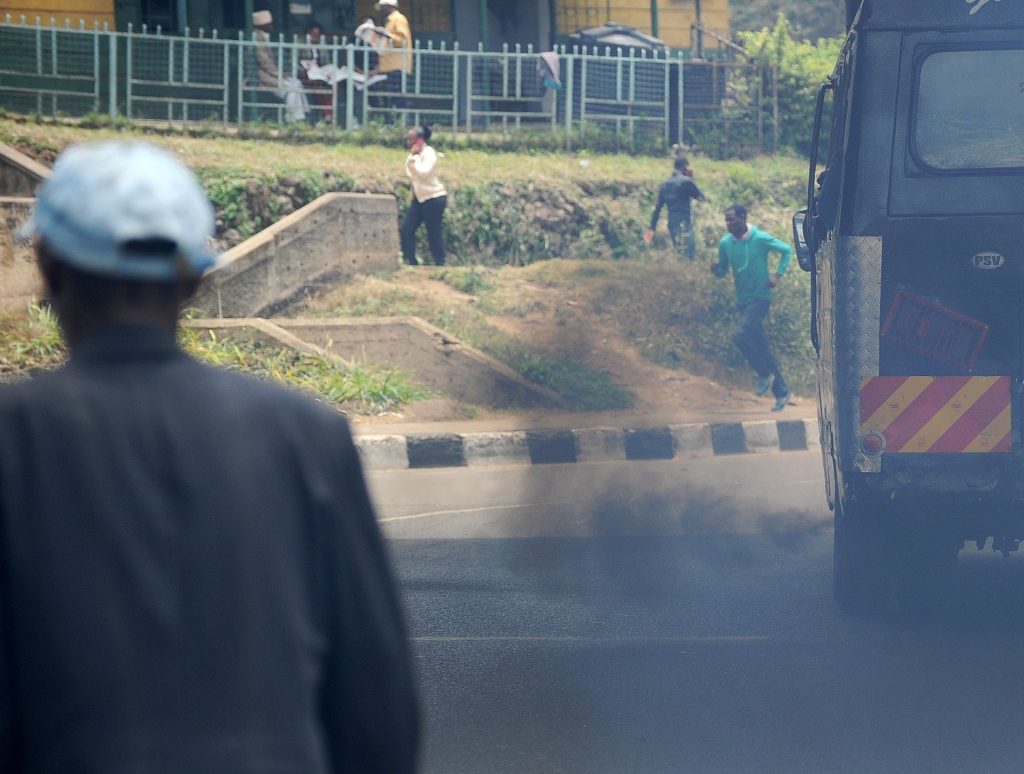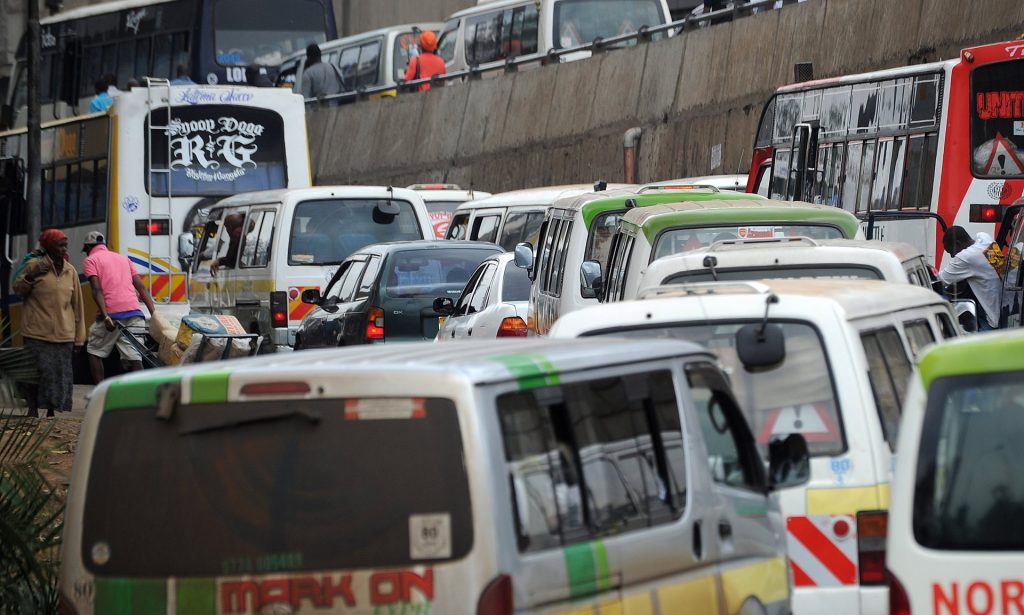A minibus belches black smoke; the lorry behind it in the traffic jam billows white fumes. Eyes smart in the smog as diesel gases from thousands of 10 and 15-year-old vehicles fill Nairobi’s hazy evening air, adding to pollution levels that are “beyond imagination”, according to one resident. This jam could last for one, three, even five hours – last year, one stretched for 30 miles.
We could easily be in Cairo, Lagos or another African megacity, but this is the eight-lane Mombasa Road in Kenya’s capital – a permanently clogged artery in a metropolis where the number of vehicles doubles every six years.
Kenya is one of the few countries in Africa to have banned cars using the most sulphurous fuels, but what research there is suggests this is still one of the most polluted cities in the world – made worse by smoke from roadside rubbish fires, diesel generators and indoor cooking stoves.
No one knows for sure, however, because like nearly all African cities, Nairobi does not regularly monitor its urban air quality.
“In 28 years of living in Nairobi, I have seen the number of people quadruple and car ownership go from 5% to 27% of people. The pollution is mind-boggling,” says Dorothy McCormick, a Nairobi university economics researcher and author of books on African transport.
“There are 16 times as many vehicles on the road as when I came – the city just cannot cope. We have no tarmac left, no congestion charge and people use charcoal, paraffin and wood to heat their homes. You can see the haze building up from the early morning. What do you do – stop breathing? There is no escape.”
With half the world’s population growth over the next 30 years predicted to occur in Africa, the United Nations Environment Programme (Unep) expects the number of cars in African cities to rise dramatically. “The vehicle fleet will double in the next seven years in Nairobi,” says Rob de Jong, Unep’s head of transport. “The number of cars in Africa is still relatively small, but the emissions per vehicle are much higher [than the rest of the world].”

Photograph: Tony Karumba/AFP/Getty Images
Africa’s urban air is especially bad because so few cars are new, the vast majority having been shipped in secondhand from Japan and Europe with their catalytic converters and air filters dismantled. It is in danger of becoming a dumping ground for the world’s old cars – importing vehicles that no longer meet rich countries’ pollution standards.
Advertisement
Across the continent, this explosion in car numbers, coupled with people cooking indoors on wood-fired stoves, is creating an urban health crisis already estimated by the UN to be killing 776,000 people a year. If unchecked, within a generation it is likely to kill twice as many annually, with devastating costs to public services and economies.
“Africa is urbanising and ‘motorising’ faster than any other region in the world,” says De Jong. “Its pollution is not yet level with New Delhi or Beijing, but it is getting there quickly. Respiratory diseases are now the number one disease in Kenya – and that is directly linked to air pollution. It is rapidly on the rise.”
According to Marie Thynell, an urban researcher at Sweden’s Gothenburg University who led a study of Nairobi pollution in 2015, the amount of cancer-causing elements in the air within the city is 10 times higher than the threshold recommended by the World Health Organisation.
Thynell’s research uncovered dramatic pollution spikes on all of Nairobi’s main roads. “The pollution is uncontrolled and particularly deadly in slum districts and for drivers, street vendors and traffic police,” she says.
Michael Gatari, an environmental scientist at the Kenyan Institute of Nuclear Science and Technology, predicts the country will have “a very sick population in years to come. Even what limited data there is suggests it is around 30 times worse than in London, and that Kenya is building up an immense health problem. Thirty percent more diesel is being burned in Nairobi compared with five years ago. Without doubt, the pollution will have a huge economic and health impact. We will see more and more cancers and heart disease, many more asthma cases and respiratory diseases.”

Photograph: Tony Karumba/AFP/Getty Images
African air pollution is closely linked to poverty, according to Gatari. “In the slums, people light an open fire and close their windows; they are enclosed in very high pollution. Drivers mix good diesel with kerosene. There is a lot of burning of plastics and no proper incineration. Dust is blown everywhere by the wind, and there is loose soil from farming.”
In west Africa, the manmade air pollution from the string of coastal cities including Lagos, Accra, Abidjan and Cotonou is now so bad that it is mixing with natural pollutants blown from the Sahara and affecting cloud cover and rainfall, according to Mat Evans, professor of atmospheric chemistry at York University, who is leading a large-scale investigation of air pollution in the region.
“A chain of megacities is building in Africa. The continent is in the same position that China was 20 years ago – if Africa does not regulate its air pollution, it will be a disaster.”
The WHO highlighted the danger from air pollution last month when it released data on 3,000 cities worldwide. The few African cities which had any public monitoring records all had particulate (PM) levels way over UN guidelines, and four Nigerian cities were among the world’s 20 worst-ranked.
Unless action is taken, says the WHO, the continent’s urban air pollution levels could triple or quadruple within 15 years.
Onitsha, a commercial hub in eastern Nigeria, had the world’s worst official air quality. A roadside monitor there registered 594 microns/cubic metre of PM10s, and 66 of the more deadly PM2.5s – nearly twice as bad as notoriously polluted cities such as Kabul, Beijing and Tehran, and 30 times worse than London.
Evans says that African cities such as Lagos have entirely different problems to London, where “pollution is mainly due to the burning of hydrocarbons for transport that can be addressed by tackling fuel usage through electric vehicles, and car-free zones.
“African pollution isn’t like that. There is the burning of rubbish, cooking with inefficient solid fuel stoves, millions of small diesel electricity generators, cars which have had their catalytic converters removed and petrochemical plants, all pushing pollutants into the air over the cities.
“Compounds such as sulphur dioxide, benzene and carbon monoxide that have not been a problem in western cities for decades may be a significant problem in African cities. We simply don’t know.”
One important step forward, according to De Jong, would be to stop the dumping of old cars in Africa. “If African countries could set an age limit on imports, they could quickly improve pollution, and leapfrog technologies. The majority of vehicles which will be on the road in Africa in 10 years’ time are not here yet. If these countries impose higher import standards, the majority of the fleet will soon be compliant – but if we wait nine years, the majority of cars will have come to Africa and it will be locked in to heavy pollution.”
De Jong advocates the widespread introduction of electric bikes in Africa: “In China there will be 300 million of them by 2020. They are cheaper than petrol – it’s purely a policy and awareness problem.
“The problem can be avoided by acting now. There is a massive opportunity for Africa to go down another road. Its air pollution must be a priority for the world.”

